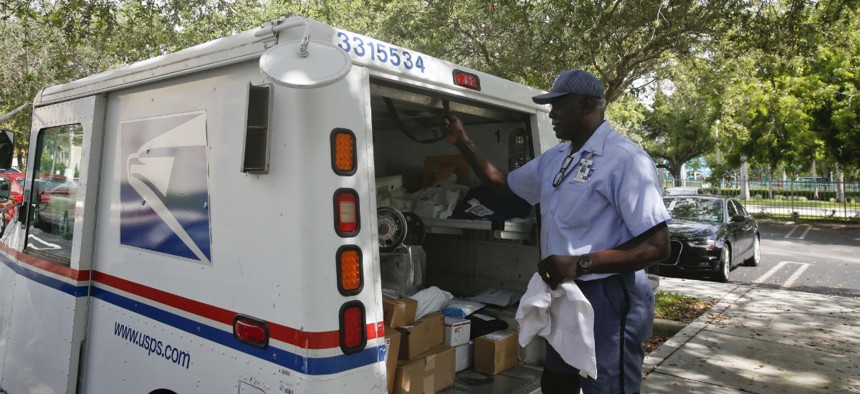
Brynn Anderson / AP
USPS Faces Difficult Choices on How to Spend Its Limited Resources
The Postal Service plans huge increase in capital investments over the next decade, if it can afford them.
The U.S. Postal Service has deferred spending on capital investments on things like vehicles and mail processing equipment over the last 10 years, according to a new report, and will likely face difficult choices on how to invest its limited funds over the next decade.
USPS has for years struggled to stay in the black financially, with diminishing revenues from declining mail volume failing to keep up with its expansive costs. That has led the agency to cut back on improvements it otherwise would have made to its facilities and other parts of its operations. The Postal Service plans to ramp up its spending on capital investments to $2.4 billion per year over the next 10 years, according to a report from the Government Accountability Office, up from $1.4 billion over the last 10.
Those plans could be in flux, however, as USPS revenues continue to drop precipitously. The agency is dealing with “organizational uncertainty,” GAO said, which could mitigate “USPS’s ability to remain competitive and achieve its mission.”
“In the absence of adequate revenues that would cover all of USPS’ expenses, these uncertainties may affect the extent to which USPS can undertake its identified capital-spending plans,” the auditors said.
Further deferments will hit the Postal Service hard, according to GAO, as 80 percent of its capital expenditures go toward sustaining its operations. Since 2009, the agency has only invested in projects deemed necessary to ensure the health and safety of its workforce and customers. Projects that created a large return on investment were also permitted.
The uptick in capital expenditures stems primarily from the agency’s plan to overhaul its entire fleet. Delays in making the purchases have proven costly for the Postal Service. Its average vehicle is decades old, forcing the agency to pay an average of $4,500 annually on maintenance per vehicle. It plans to spend $5.7 billion over the next decade to replace its fleet, with the acquisitions spread out over several years. USPS has issued a request for proposals, but is still testing various prototypes and has not yet selected a vendor.
The Postal Service plans to spend an average of $607 million per year on its facilities over the next decade. Most of those expenditures will go toward maintaining existing buildings, as declining volumes have largely ended the need for new facilities. The agency also plans to spend $541 million annually on information technology improvements, mostly to better protect against cyber threats, and $464 million per year on mail processing equipment. The latter investment nearly always creates a positive return for USPS, GAO said, by providing it with more efficient operations and increased automation.
Even as the Postal Service deferred investments in recent years, it spent 18 percent less on average annually than it had budgeted for capital investments between fiscal years 2007 and 2017. USPS maintains a multi-layered process to approve any capital spending. Each department sets its own ranked priorities for projects in which it would like to invest, which are then approved by postal leadership and subsequently by the board of governors. In addition to projects necessary for health and safety and those that boost revenue, USPS invests in projects that help it meet its organizational objectives and maintain its universal service mandate.
Postal management already maintains various processes to help it determine how to prioritize its projects. It conducts risk assessments that are regularly updated, providing the agency with guidance when its has to cut investments it had planned. Last year, for example, the Postal Service did not make a payment of nearly $7 billion in required prefunding payments for retirees health and pension benefits. Instead, the agency said, it had to reserve that money to continue to provide service and to maintain “sufficient cash reserves for capital spending.”
GAO said those processes will help the agency if revenues decline even more than the agency anticipates, or if customers like Amazon increasingly rely on their own delivery network and shipping volumes stop growing.







